Oh, boy.
It’s time to write the climax of your screenplay or novel.
This (along with the resolution) is your last chance to prove to readers that you are a crazy-good storyteller.
Which means you can’t drop the ball.
You promised readers a gripping story, and you must deliver—right up until the last second.
You can’t just wrap up everything quickly because you’re:
- tired from dealing with the headache of writing the middle
- itching to move on to your next story
No, you can’t do that.
Then your novel or screenplay will feel anticlimactic.
And readers will react accordingly.
Your novel will get docked a star in a review; your script will get a pass instead of a consider.
To avoid these disappointing outcomes, you can’t disappoint your readers.
You must learn how to write the climax of a story in a way that prolongs the tension and keeps readers under suspense for as long as you can.
That’s what this writing article is all about.
In it, I’ll share some of my best tips on how to increase tension at the climax of a novel or screenplay—so your ending will be such a nail-biter, readers won’t be able to put down your story.
Ready to keep your readers up until 2 AM?
Let’s go!
How to Write the Climax Tip #1: Don’t take the stakes out of play too early.
Stakes—the negative consequences of failure—fuel the climax.
When they’re out of play (i.e. the safety or happiness of the protagonist or another character is no longer in question), there’s nothing for readers to worry about.
There’s no more tension.
Your climax is over.
Despite this, writers are inclined to take the stakes out of play prematurely, likely because they’re:
- in a haste to get their draft over and done with
- too overprotective of their characters (and don’t want to see them struggle anymore)
But to maintain the tension at the climax of your screenplay or novel, you can’t yield to these urges.
You must keep the stakes in play for as long as possible.

Keep in mind, you don’t have to keep the stakes the same throughout the climax.
In fact, changing them up is a great way to keep the climax going, while at the same time, preventing it from feeling monotonous.
By the way, if you’d like to learn how to use stakes to create an epically long story climax (in the action or romance genres), I walk you through it, step by step, in Lesson 3.7 of my online course on story structure. Click here for more details.
How to Write the Climax Tip #2: Remind audiences that the clock is ticking.
Maybe I should backtrack a bit.
This tip assumes that there’s a deadline in place in your story already.
Your protagonist must solve his problem or achieve his goal by a certain time—or else.
The “or else” hanging over your protagonist’s head refers to the stakes. And, as previously established, they are key to creating tension.
However, you can amplify that tension considerably by narrowing that window of time.
In other words, at the climax, your protagonist should be down to the wire.
Instead of days or hours, your protagonist has mere minutes or seconds to turn everything around.
As Janice Hardy explains on Fiction University, this will get your story read “in a breathless rush as readers are desperate to see how it all turns out.”
To create that sense of desperation, though, you need to remind audiences that time is running out.
An effective (but not exactly innovative) way to do this is by:
- showing a clock
- having a character verbally count down the time to the protagonist
In the excerpt below from The President Is Missing by Bill Clinton and James Patterson, you can see a ticking clock in action in a novel.
To give you some context, the president and his team have to come up with a password (they call it a keyword) to disable a computer virus that could tumble the United States into the Dark Ages.
“We have a keyword, and we have…”
I look at my phone, which has a timer of its own that I synced up with the virus’s timer.
4:26
4.25“…four and half minutes to figure it out. We tried every variation of her name, of Augie’s name, of Suliman Cindoruk’s name, of ‘Abkhazia’ and ‘Georgia’ and ‘Sons of Jihad.’ I need ideas, people, and I need them now.”
“What’s her birthday?” asks the CIA director, Erica Beatty.
[None of the date variations work.]
3:57
3:54My eyes on Vice President Kathy Brandt, who so far has remained silent.
Then Kathy lifts her head. “What about her family? Family names. Mother, father, siblings.”
[None of the family names work.]
3:14
3:11
If possible, try to get more creative with the way you represent time.
A tried-and-true method in an action movie is to use declining levels of fuel. Rising tides also work well.
In a rom-com, you might see a ticking clock created out of the scheduling associated with transportation or special occasions.
In 27 Dresses, for example, a boat hosting a wedding reception turns into a ticking clock. Once the boat leaves the dock, the heroine will lose her chance to talk to the hero and win him back.
Deadlines (and their corresponding ticking clocks) are what I refer to as modulating factors.
When used properly, modulating factors make readers feel more intensely about the same set of story stakes.
They’re how you distinguish your save-the-world or falling-in-love plot from everyone else’s—and rise above the competition.
If you’re interested, I discuss seven additional modulating factors—and how to use them to heighten the emotional intensity of your story stakes—in chapter 2 of my writing guide Story Stakes.
How to Write the Climax Tip #3: Make sure your protagonist and antagonist are evenly matched.
To explain this tip, let’s examine how the scenario looks when your protagonist and antagonist aren’t evenly matched.
Having acquired special powers or a high-tech weapon, your protagonist has become invincible.
And now, at the climax, she’s squaring off against the antagonist for the last time.
Will readers be worried about her?
Of course not.
Why should they be?
She’s invincible. She’s not exposing herself to any real danger. Her victory is a foregone conclusion.
No matter what dazzling feat your protagonist engages in, your climax will be boring. There’s no tension—no reason for readers to bite their nails in nervous anticipation of what will happen next.
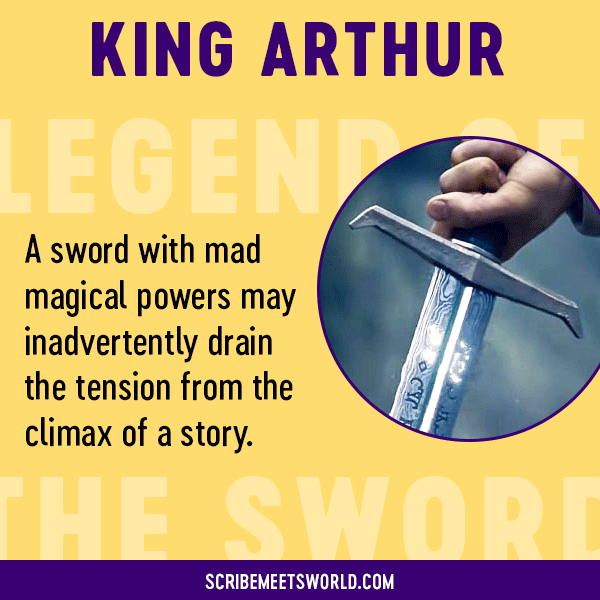
To keep the tension high during your grand finale, you need to make sure your protagonist’s resources and skills are on par with your antagonist’s.
They should be so evenly matched that readers shouldn’t be able to predict the outcome of the climax (unless they’re banking on the fact that most stories do, indeed, end happily).
Want more advice on this topic?
I gotchu.
For pro tips on how to keep your protagonist and antagonist evenly matched, read this.
Now, you might be thinking there’s no way that you would ever do something like this. You’d always depict the antagonist as a worthy adversary in your novels or screenplays.
But I have to call you out on this, fellow scribe.
You may identify strongly with your protagonist—and the entire plot of your story may be your own wish-fulfillment fantasy.
In a situation like this, it’s likely that you’ve made your protagonist a badass and your antagonist a weakling. Hey, no judgment. It’s wish fulfillment, after all.
Because of your strong identification with your protagonist, experiencing his exploits may be immensely thrilling for you.
But for your readers? Not so much.
For the love of all that is bookish (or cinematic), please stop piling all the advantages onto your protagonist.
One last point: we’ve been talking about the scenario where the protagonist is vastly superior to the antagonist.
With the reverse case—where the antagonist is vastly superior to the protagonist—it’s a different kettle of fish.
Then the tension is high.
Exceedingly high.
Readers will stew over the fate of the protagonist, who seems out of his league on every level.
However, if you are not careful, this scenario may ultimately lead to a weak, unsatisfying ending. It all depends on how you rescue your protagonist from his dicey predicament.
More details in the next tip…
How to Write the Climax Tip #4: Build in a false-defeat story beat.
What is the false defeat?
Well, it comes in a couple of different sizes. But the one we’re taking about now is similar to the “all is lost” moment at the end of Act Two.
It’s the moment at the tail end of the climax when it seems—despite everything the protagonist has done so far—it’s impossible for him to defeat his antagonist.
The protagonist is going to lose.
Big time.
It’s a great way to increase tension at the end of a novel or screenplay because it compels readers to wonder how in the world your protagonist is going to extricate himself from this dire predicament.
But it has other benefits as well. Namely, it helps you create the roller-coaster ride that readers are looking for.
As Chris Vogler explains it in The Writer’s Journey:
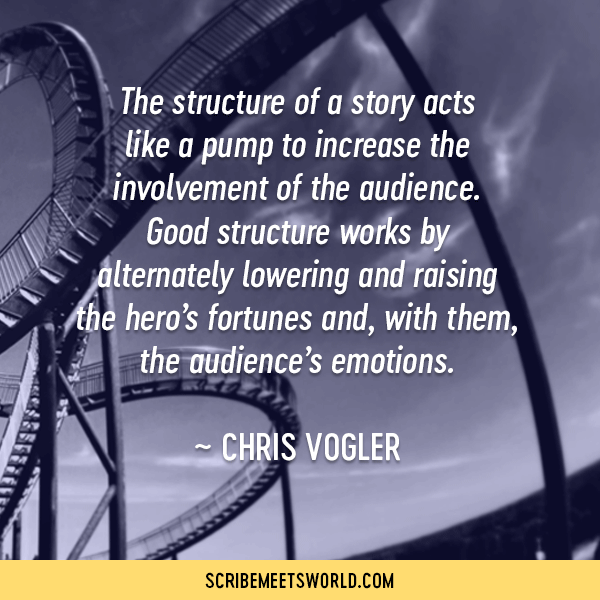
With the false defeat, audience emotion goes from an extreme low to an extreme high (this, of course, assumes a happy ending…and that the false defeat is, in fact, false).
Without it, audience emotion doesn’t have the same opportunity to rebound, and their experience will be less intense, and therefore, not as satisfying.
However, to achieve the effect you’re aiming for, you have to take care with how you extricate your protagonist from his predicament.
You can’t just rescue him through a miracle or contrivance. That’s what’s known as deus ex machina.
It’s lazy writing, and readers hate it.
Want more details about deus ex machina (including three easy ways to avoid it)? Then click here.
How to Write the Climax Tip #5: Append an aftershock to the end of the climax.
The last technique to increase tension at the climax of your story is the aftershock.
Here’s how it works:
The stakes finally go out of play (not prematurely; see tip #1). It seems like the protagonist has succeeded and your story is cruising toward the resolution.
Only—surprise!—the safety or happiness of the protagonist (or another character) is put into jeopardy once more. That is, stakes are put into play again.
A classic example of an aftershock can be found at the end of Die Hard. Watch the clip now:
Because the aftershock pulls the rug from underneath the feet of audiences right when they’re starting to relax, it can be one of the most memorable moments of your novel or screenplay.
Plus, the aftershock can be a great way to maintain gender balance without undermining your protagonist’s status as the protagonist.
For example, if your protagonist is male, he can save the day at the tail end of the climax. As the protagonist, that glory belongs to him.
But his female partner shouldn’t be left in the shadows. She should still have a chance to shine. The aftershock can provide her with that opportunity.
Another benefit: the aftershock enables you to extend the duration of your story climax.
Let me explain why this is important. For your story climax to delight readers, it needs to pass three quality control tests:
- personal agency
- stakes
- escalation
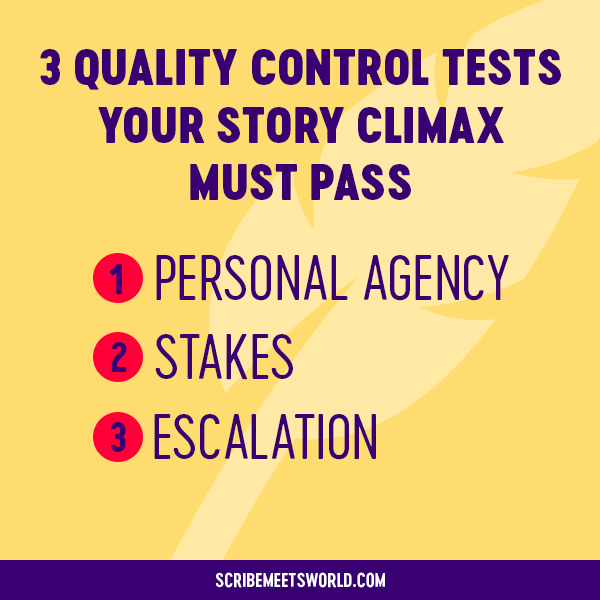
Extending the length of your story climax helps you pass the last of those tests, escalation.
When your story escalates well, readers will have the impression that it’s gotten better as it went along. Hence, they’ll be poised to recommend it to everyone they know.
Naturally, when your story doesn’t escalate well—and you end on a pocket of anticlimax—you’ll get the opposite result.
When you end your story with a short, wimpy climax, you’ll sour your readers’ experience. Their delight over your standout beginning and middle will turn into disappointment.
Don’t want to sabotage the climax of your story? Then make sure to end strong, with a climax of suitable length.
If you’d like to use the aftershock to extend the duration of your story climax (or for its other benefits)…
…but are stumped about what to use for an aftershock, I list six options in:
- Lesson 3.9 of my online course Smarter Story Structure
- Chapter 6 of my writing guide Story Climax
Going Further with Your Story Climax, Story Stakes, and Story Structure
Did you notice that, in this article, about half of the tips to increase tension at the climax pertain to the stakes?
That’s because the two go hand in hand.
To write a real nail-biter of a climax, you must pay close attention to how (in addition to other factors), you use story stakes.
If you’d like to learn more practical tips for passing all three climax quality-control tests (personal agency, stakes, and escalation), then check out my writing guide Story Climax.
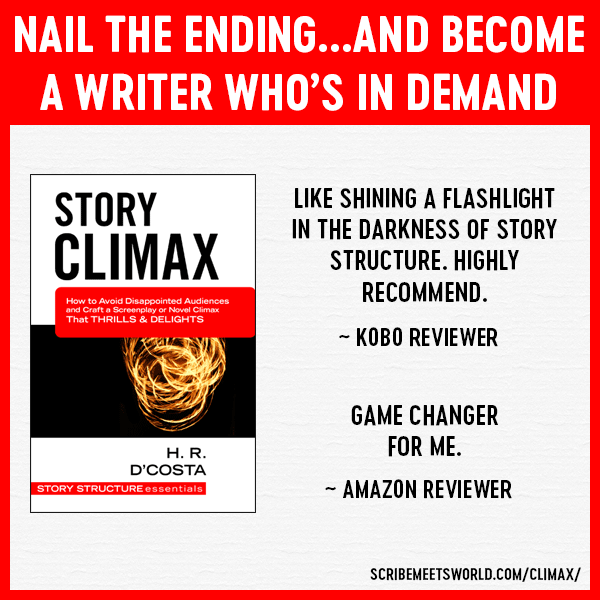
If you’d like to focus exclusively on deepening your understanding of the stakes—which are crucial not only to enhancing your story climax but also to getting audiences to care about what happens in your story—then take a look at Story Stakes.
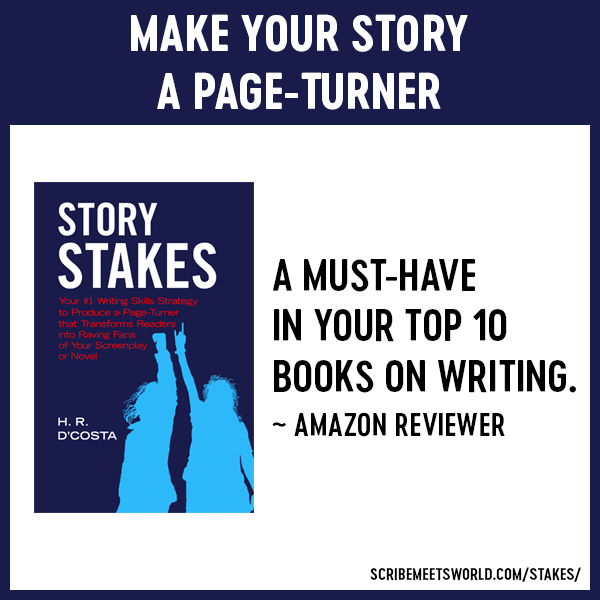
If you want to become better at all aspects of story structure (not just the climax):
- Download the Ultimate Story Structure Worksheet. (A free, 18-page worksheet that’ll help you plot your next screenplay or novel like a boss.)
- Read the writing guides in my Story Structure Essentials series. (You’ll get a “deep dive” on how to set up your story for success, say good-bye to saggy middles, and craft endings that exceed audience expectations.)
- Enroll in my online course Smarter Story Structure. (Distills years of studying why some stories are so gripping—while others are easy to walk away from—into 30 bite-sized lessons. Perfect if you want to learn how to wield story structure like a pro, in the shortest amount of time.)

Nail-Biter by Thomas Kelley; Girl and bear by Hassan OUAJBIR; Roller coasters by Mark Asthoff




















